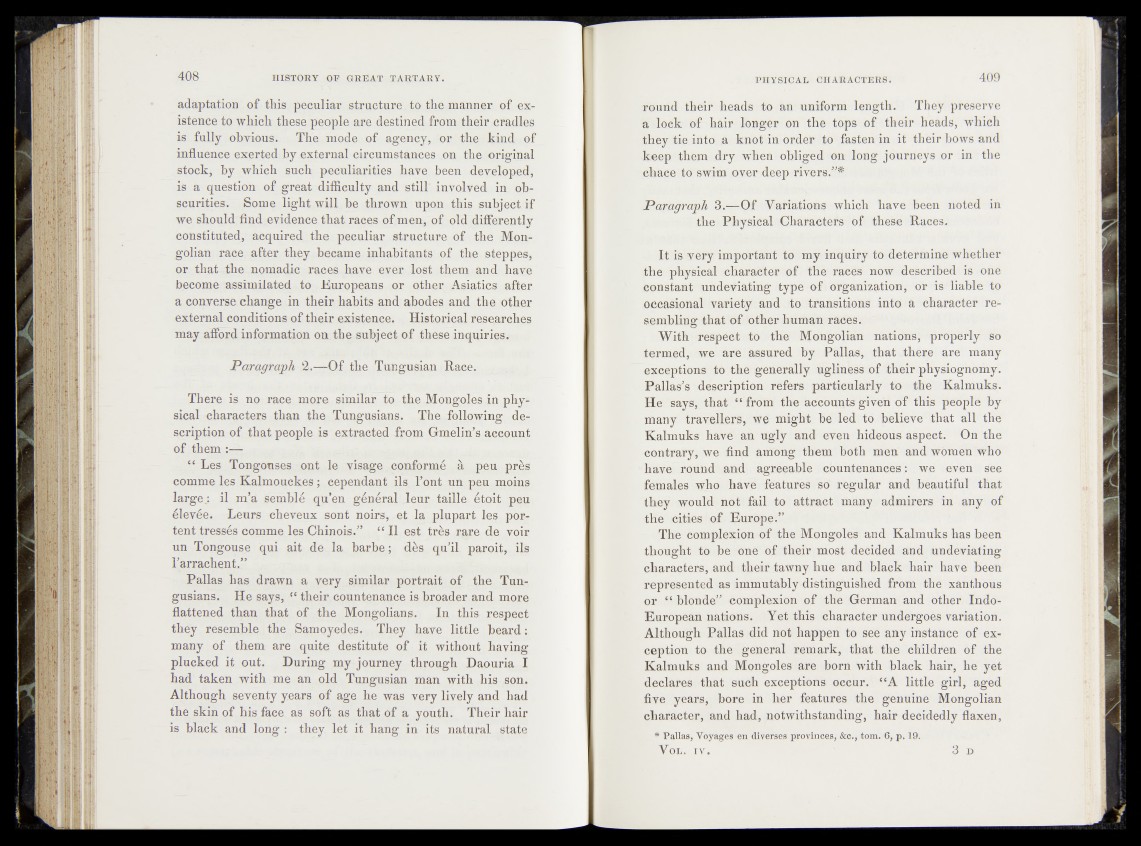
adaptation of this peculiar structure to the manner of existence
to which these people are destined from their cradles
is fully obvious. The mode of agency, or the kind of
influence exerted by external circumstances en the original
stock, by which such peculiarities have; been developed,
is a question of great difficulty and still' involved in obscurities.
Some light will be thrown upon this subject if
we should find evidence that races of men, of old differently
constituted, acquired the peculiar structure of the Mongolian
race after they became inhabitants of the steppes,
or that the nomadic races have ever lost them and have
become assimilated to Europeans or other Asiatics after
a converse change in their habits and abodes and the other
external conditions of their existence. Historical researches
may afford information on the subject of these inquiries.-
Paragraph 2.—Of the Tungusian Race.
There is no race more similar to the Mongoles in phyf
sical characters than the Tungusians. The following description
of that people is extracted from Gmelin’s,account
of them ;
“ Les Tongotises ont le visage conformé èfciï.peu près
comme les Kalmouekes ; cependant ils l’ont un peulvmoins
large.: il m’a semblé qu’en général leur taille
élevée. Leurs cheveux sont noirs, et la plupart les portent
tressés comme les Chinois.”^ /“ Il est très rare de voir
un Tongouse qui ait de la barbe; dès qu’il paroit, ils
l’arrachent^’
Pallas bas drawn a very similar portrait of the Tun-
gusians. He says, “ their countenance is broader and more
flattened than that of the Mongolians. In this respect
they resemble the Samoyedes. They have little beard :
many of them are quite destitute of it without having
plucked it out. During my journey through Daouria I
had taken with me an old Tungusian man with his son.
Although seventy years of age he was very lively and had
the skin of his face as soft as that of a youth. Their hair
is black and long : they let it hang in its natural state
round their heads to an uniform length. They preserve
a loek of hair longer on the tops of their heads, which
they tie into a knot in order to fasten in it their bows and
keep them dry when obliged on long journeys or in the
ehace to swim over deep rivers.’’*
Paragraph 3.—Of Variations which have been noted in
the Physical Characters of these Races.
It is very important to my inquiry to determine whether
the physical character of the races now described is one
constant undeviating type of organization, or ts: liable to
occasional variety and to transitions into a character resembling
that of other human races.
With respect to the Mongolian nations, properly so
termed, we are assured by Pallas, that there are' many
exceptions to the generally ugliness of their physiognomy.
Pallas’s description refers particularly to the Kalmuks.
Het''says, that “ from the kdcounts given of this people by
many travellers, we might be’led to believe%hat all thd’
Kalmuks have an ugly andveven hideous aspect. On the
contrary, we find among them both men and women whll
have round and agreeable countenances; we <‘even see
females who have features so‘ regular and beautiful that
they would not fail to attract many admirers in any of
the cities of Europe.”
The complexion of the Mongoles and Kalmuks has been
thought to be one of their most decided and undeviating
characters, and their tawny hue and black hair have been
represented as immutably distinguished from the xanthous
or “ blonde” complexion of the German and other Indo-
European nations. Yet this character undergoes variation.
Although Pallas did not happen to see any instance exception
to the general remark, that the children of the
Kalmuks and Mongoles are born with black hair, he yet
declares that such exceptions occur.’ “A little girl, aged
five years, bore in her features the genuine Mongolian
character, and had, notwithstanding, hair decidedly flaxen,
* Pallas, Voyages en diverses provinces, &c., tom.-6, p. 10.
VOL. TV. I 9 3 D